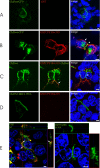Molecular determinants of the interaction between Clostridium perfringens enterotoxin fragments and claudin-3
- PMID: 19429681
- PMCID: PMC2707212
- DOI: 10.1074/jbc.M109.008623
Molecular determinants of the interaction between Clostridium perfringens enterotoxin fragments and claudin-3
Abstract
Clostridium perfringens enterotoxin (CPE) binds to the extracellular loop 2 of a subset of claudins, e.g. claudin-3. Here, the molecular mechanism of the CPE-claudin interaction was analyzed. Using peptide arrays, recombinant CPE-(116-319) bound to loop 2 peptides of mouse claudin-3, -6, -7, -9, and -14 but not of 1, 2, 4, 5, 8, 10-13, 15, 16, 18-20, and 22. Substitution peptide mapping identified the central motif (148)NPL(150)VP, supposed to represent a turn region in the loop 2, as essential for the interaction between CPE and murine claudin-3 peptides. CPE-binding assays with claudin-3 mutant-transfected HEK293 cells or lysates thereof demonstrated the involvement of Asn(148) and Leu(150) of full-length claudin-3 in the binding. CPE-(116-319) and CPE-(194-319) bound to HEK293 cells expressing claudin-3, whereas CPE-(116-319) bound to claudin-5-expressing HEK293 cells, also. This binding was inhibited by substitutions T151A and Q156E in claudin-5. In contrast, removal of the aromatic side chains in the loop 2 of claudin-3 and -5, involved in trans-interaction between claudins, increased the amount of CPE-(116-319) bound. These findings and molecular modeling indicate different molecular mechanisms of claudin-claudin trans-interaction and claudin-CPE interaction. Confocal microscopy showed that CPE-(116-319) and CPE-(194-319) bind to claudin-3 at the plasma membrane, outside cell-cell contacts. Together, these findings demonstrate that CPE binds to the hydrophobic turn and flanking polar residues in the loop 2 of claudin-3 outside tight junctions. The data can be used for the specific design of CPE-based modulators of tight junctions, to improve drug delivery, and as chemotherapeutics for tumors overexpressing claudins.
Figures







References
-
- White R. E. (2000) Annu. Rev. Pharmacol. Toxicol. 40, 133–157 - PubMed
-
- Mizuno N., Niwa T., Yotsumoto Y., Sugiyama Y. (2003) Pharmacol. Rev. 55, 425–461 - PubMed
-
- Aungst B. J. (2000) J. Pharm. Sci. 89, 429–442 - PubMed
-
- Salama N. N., Eddington N. D., Fasano A. (2006) Adv. Drug Deliv. Rev. 58, 15–28 - PubMed
-
- Hochman J., Artursson P. (1994) J. Control. Release 29, 253–267
MeSH terms
Substances
LinkOut - more resources
Full Text Sources
Other Literature Sources
Research Materials
Miscellaneous

